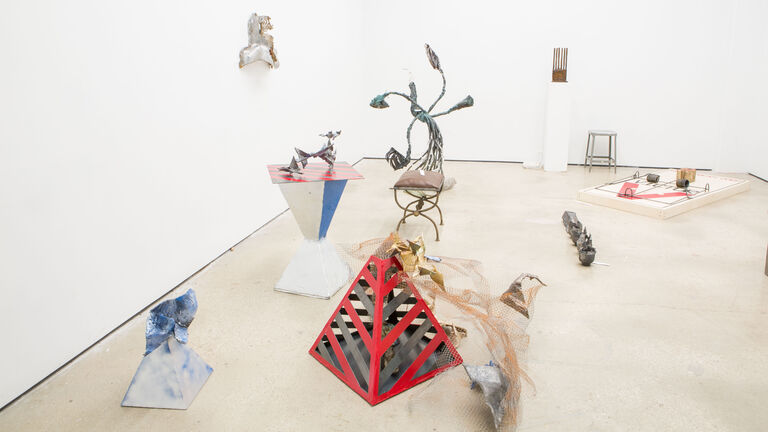
Graduate Overview
Graduate Overview
Application Deadline: January 10
SAIC’s Sculpture department encourages students to create fluidly, from casting bronze to organizing public spectacles, from growing food to fabricating via high-tech digital machinery.
SAIC’s highly regarded Sculpture department houses one of the most innovative programs in the world. We are committed to giving form to social, environmental, and theoretical concerns. The department facilitates experimentation and engagement with site-based projects, metal casting, mold-making, figure studies, sustainable materials and systems, research-based and science-related projects, and international exhibition and curatorial practices. The program also supports contemporary and interdisciplinary processes and skills, including mixed-media installation, video- and web-based projects, puppetry, public art proposals and practices, and 3D digital modeling and fabrication.
Sculpture MFA Learning Goals
- Students will create sculptural works that demonstrate a broad-based awareness of the field.
- Students will learn to experiment in order to gain knowledge and acquire technical proficiency.
- Students will engage material and process towards an outcome.
- Students will develop an appreciation of the complexity of sculptural meaning.
- Students will formulate, present and defend their ideas towards an independent criticality
- Students will develop an independent creative practice that exemplifies expertise, focus, and self-discipline towards a sustainable professional practice.
Inside the Studio, Around the Globe
Graduate students are encouraged to consider their art-making process as an interdisciplinary practice. The graduate sculpture seminar immerses first-year students in graduate-level critique, writing, and theory. The department encourages students to move outside the studio with projects worldwide. Local and international visiting artists also present a range of sculptural perspectives and practices in lectures and critiques throughout the year.
Professional Preparation and Collaboration
Graduate Sculpture students present their work in a public lecture series called Dialogues, an amalgam of our visiting lecture series and graduate presentations—providing an opportunity for us to more deeply engage with invited artists, scholars, writers, and curators with a particular emphasis on Chicago's Art Ecology.
Combined with interdisciplinary critiques and seminars, this environment inspires interdepartmental collaborations among MFA students. Our Sculpture “bootcamp” skills-based course provides specific skills and opportunities for the development of one’s work and professional practice.
Exhibitions of student work in the on-campus sculpture gallery, the presence of a greenhouse and growing space in the courtyard, and special events such as the off-campus iron pour each spring encourage interaction among students and faculty and build community in the department. The department is also committed to collaborative exhibitions, community-based projects, and environmental art.
Graduate Projects
The cornerstone of SAIC's graduate studio program is its focus on tutorially guided studio practice. Each semester in addition to selecting from graduate advisors in the department, you will select from more than 100 graduate faculty advisors at SAIC, representing myriad disciplines, approaches, and intellectual positions. Ultimately, it is the student's work that drives the choice of advisor, and both disciplinary and interdisciplinary work is supported and advanced. Faculty from the academic programs in Art History, Arts Administration and Policy, Art Education, and Visual and Critical Studies also serve as graduate advisors, providing yet more expertise in support of SAIC Graduate Projects.
Critique Week
Critique Week, one of the principal means of assessment each semester, is a week-long schedule of critiques during which classes are suspended and the entire faculty and invited visiting artists and designers assemble into panels that conduct intensive studio critiques with all studio and writing graduate students.
Fall semester critiques are organized by department, with panels representing the discipline. They provide you an opportunity to have your work evaluated by the department, look at your work from a disciplinary point of view, and reinforce the expectations for your graduate study.
Spring semester critiques are interdisciplinary, with panel members of faculty, visiting artists, and peers from across SAIC departments. Interdisciplinary critiques in the spring semesters allow for a broader range of responses to the work, and are intended to assess the success of your work for a more general, yet highly informed, audience.
Studio critiques are required of every full-time graduate student pursuing an MFA in Studio or Writing degree. Typically, SAIC graduate students have at least four critique panels throughout their studies at SAIC, augmenting biweekly tutorials with their graduate advisors.
Take the Next Step
Graduate Admissions Events
Learn how to prepare a competitive application, meet with faculty and staff, and explore our programs and facilities. LEARN MORE
MFA in Studio Admissions Information
Curriculum & Courses
Continue to explore the SAIC Sculpture department website to learn about our curricular offerings, faculty, students, and alumni, visit the Master of Fine Arts in Studio degree program for more detailed information, or schedule a tour. Visit the graduate admissions website or contact the graduate admissions office at 312.629.6100, 800.232.7242 or gradmiss@saic.edu.